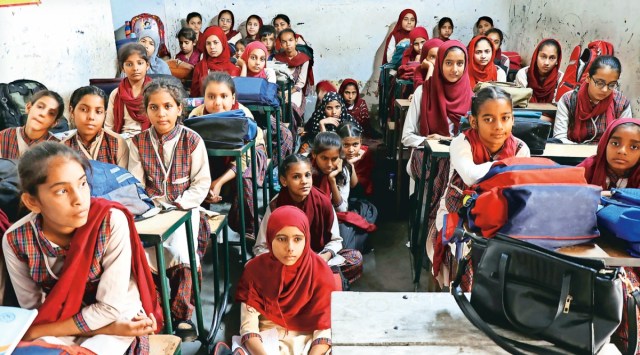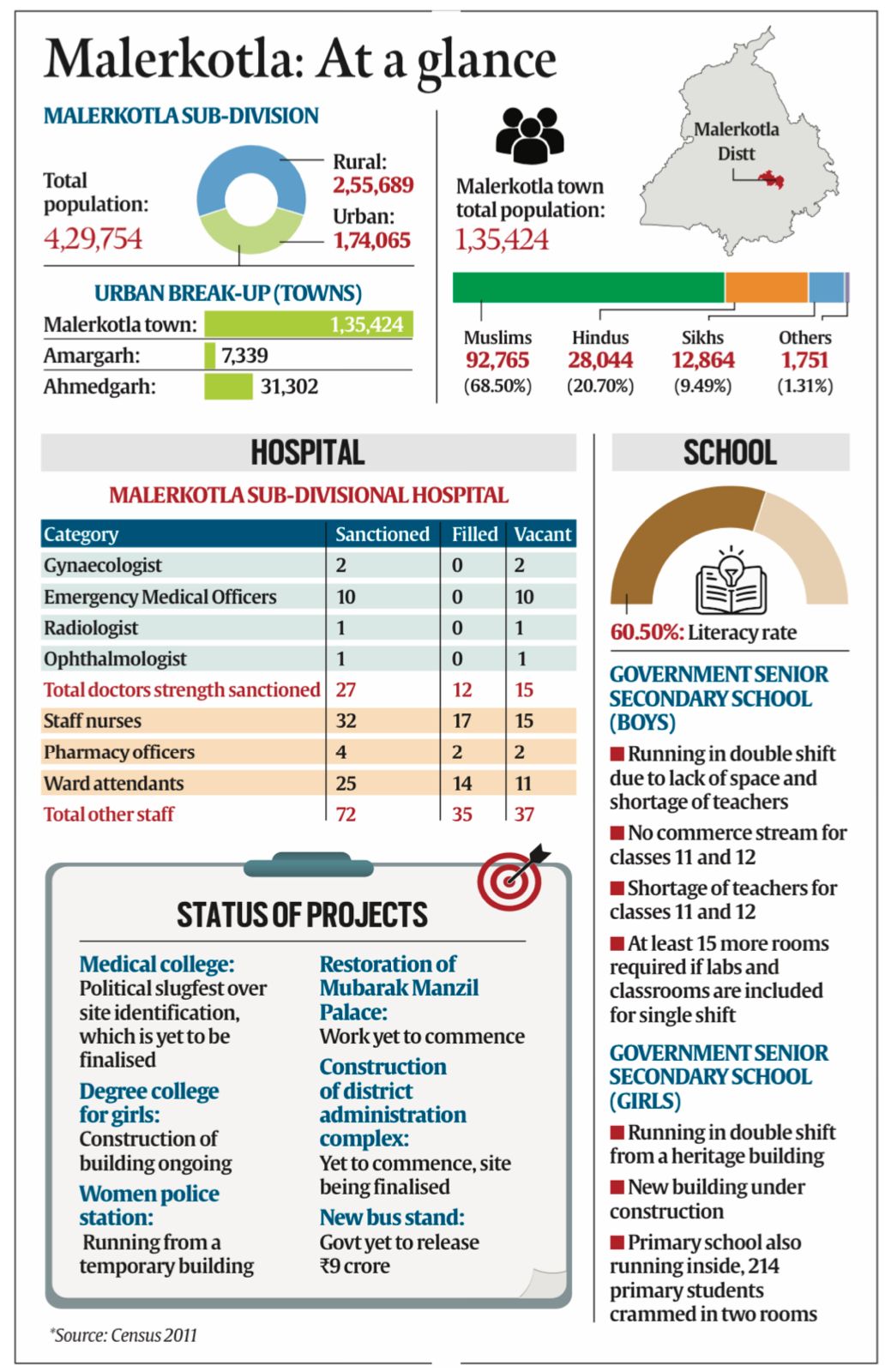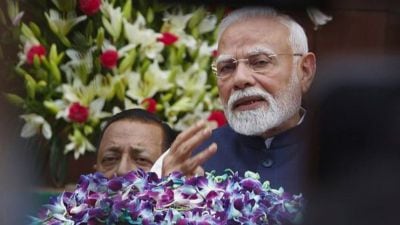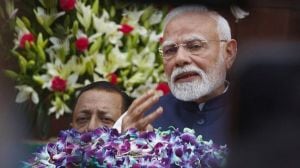Ground Report: For Punjab’s newest district, Malerkotla, a long road ahead
Two years after becoming a district, state’s only Muslim-majority town — Malerkotla — lacks doctors, has muddy stretches in the name of roads, classrooms cramped with students; residents call it ‘naam ka zila’
 Students crammed into a classroom at Government Senior Secondary School for Girls in Malerkotla. (Gurmeet Singh)
Students crammed into a classroom at Government Senior Secondary School for Girls in Malerkotla. (Gurmeet Singh) It’s around 1 pm and in the sweltering heat, the corridors of Emergency at sub-divisional hospital (SDH) Malerkotla are bustling with restless voices. A queue of patients waits for their turn. Standing since 8 am, many rue that it would be another day wasted, and the ordeal will again begin tomorrow.
Begum Majidan, a khet mazdoor (farm laborer) who has been leaving her day’s work every day to visit the hospital, hasn’t been lucky enough to be called by the lone doctor inside. “My reports have confirmed that I have kaala peelia (hepatitis-C). Every day I visit the hospital to get checked but we stand here in queue till 2 pm and are asked to come again tomorrow. Is this what it means to be a part of a district now,” the 60-year-old asks.
Safia (42), another hepatitis-C patient adds, “It takes something to stand in a queue for six hours and then come again the next day. While medicines are available here at a much lesser price, I have purchased the costlier ones from outside. But I have already spent over Rs 10,000 on my tests and medicines but there’s no one to check here.”
 Malerkotla at a glance
Malerkotla at a glance
Habiban Khan (49), whose knees give up as she squats on the ground, says: “Labourers like us, who earn on an hourly basis, cannot spend the whole day waiting for doctor to call us inside. There are hundreds standing here but there’s only one doctor inside to treat us. We stand here for hours, and then come back again the next day. The cycle continies and it’s my 9th day at the facility today.”
 The pothole-ridden Malerkotla-Nabha road
The pothole-ridden Malerkotla-Nabha road
Nearly two years after the then Punjab chief minister Captain Amarinder Singh announced the formation of the Muslim-majority town and the adjoining towns of Amargarh and Ahmedgarh as the 23rd district of Punjab as an “Eid gift”, the youngest and tiniest district of Punjab, which also holds special significance in Sikh history, is still grappling with problems of the past.
What hurts people the most is the lack of basic amenities — muddy stretches and potholes in names of roads, government schools running in double shifts due to shortage of teachers and space, clogged drains, lack of doctors at government hospital and town’s heritage structures lying in tatters. The status of the district is only on papers as on the ground, the facilities are far from the reality of a district.
Data also corroborates the ordeal of patients at Malerkotla sub-divisional (Civil) hospital where all 10 posts of Emergency medical officers (EMOs) are lying vacant and one specialist doctor is deputed to handle emergencies every day. Of the total 27 sanctioned posts of doctors at 130-bedded hospital, 15 are currently lying vacant. Of the 32 posts of staff nurses, 15 are vacant and of 25 posts of ward attendants, 11 are vacant. And yet, one entire floor of Mother and Child Hospital on the premises has been vacated for administrative works which are now a baggage after Malerkotla became a district.
Dr Jagjit Singh, senior medical officer (SMO), who also doubles up as gynaecologist with posts lying vacant, says: “There’s extreme rush at the emergency as all posts of EMOs are currently vacant. A specialist doctor handles emergencies. However, we have already started free of cost treatment for TB, hepatitis and other diseases as per norms for district-level hospitals.”
 A cene outside the Emergency ward at Malerkotla Civil Hospital. Gurmeet Singh
A cene outside the Emergency ward at Malerkotla Civil Hospital. Gurmeet Singh
Malerkotla, an erstwhile princely state, was founded by the 15th century Sufi saint Sadruddin Sadar-i-Jahan of Afghanistan and subsequently ruled by Mughal Nawabs, is currently the only Muslim majority town in east Punjab.
With over 92,000 Muslims, 28,000 Hindus and 12,800 Sikhs accoring to the 2011 Census, the gurdwaras, mandirs and masjids intersect each other’s path in almost every street, but people of this town have always imparted some crucial lessons in the peaceful co-existence of the people here.
The unique social fabric and communal harmony of Malerkotla town has passed several tests since time immorial — be it the Partition when Muslims here chose to stay back and there was no communal violence; the Babri Masjid demolition or the Ayodhya case verdict — when the town was turned into a fortress with heavy police security, but no untoward incident was reported. It was only in June 2016, when the holy Quran was allegedly desecrated, its pages found strewn in streets, that an angry mob had resorted to arson at the house of then SAD MLA Farzana Alam, wife of former DGP Izhar Alam. That incident had happened ahead of the 2017 Punjab Assembly polls.
Standing as a testimony of Malerkotla’s communal harmony is Gurdwara Haa Da Naara Sahib, which was built by Sikh community as a tribute to erstwhile ruler of Malerkotla Nawab Sher Mohammad Khan, who had raised his voice (‘Haa Da Naara’) against brutal execution of Chhote Saahibzaade.
 Road submerged in rainwater near Dilli Gate.
Road submerged in rainwater near Dilli Gate.
Malerkotla has also earned itself a tag of being the largest vegetable producer in the state with farmers here mostly engaged in vegetable farming and the town is also the hub of plant nurseries.
At the town’s Dilli Gate, where daily wagers stand everyday as a part of “Labour Mandi” to find work, a road leading to government schools for both boys and girls, is submerged. As vehicles try to wade through potholed roads flooded with rainwater, Majid Ali, a labourer quips, “Ye sirf naam ka zila hai (It is only a district by name). Koi kaam nahi hai yahaan (There are no employment opportunities here).”
At the government senior secondary school for boys, there are 960 students from classes 6 to 12, who study here in double-shift due to shortage of classrooms and teachers. The school also doesn’t have commerce stream for 11 and 12. “We are short of at least 15 rooms if laboratories are also included. There are only 8 lecturers for class 11 and 12 while there are more than 300 students,” says principal Aarti Gupta. “Currently, we haven’t been told of any plans for a new building for the school,” she adds.
The district status has also added to this school’s problems as a portion of the building has now been vacated for the office for district education officer (DEO). Nearby, the government senior secondary school for girls also runs in double shifts from a heritage building. With more than 1,300 students, it is short of classrooms and the new building’s construction is underway. The school also houses a government primary school where 214 children have been crammed into two rooms with no word on when the primary school would get its own building.
From Dilli Gate to Sirhindi gate, entrance of the town to periphery areas, the pathetic state of Malerkotla’s roads has invited criticism. Adnan Ali Khan, a Punjab resident after his visit to the town, tweeted: “Welcome to Malerkotla.. a roadless town of Punjab.. infrastructure wise it’s worse than backward towns of Bihar/Jharkhand.. people here have lost hope in governments.. whether past or present… it used to be better when it was not a district. Now more officers, more mess and no funds..”
Work hasn’t even started on the construction of new District Administration Complex (DAC) and hence the offices of deputy commissioner and SSP are running from other government spaces.
Captain Amarinder Singh’s announcement for Malerkotla as the 23rd district of Punjab had come with a bounty of new projects. A new medical college in name of Nawab Sher Mohammad Khan for Rs 500 crore, a new bus stand (Rs 10 crore), a degree college for girls, Mahila thana (an all-women police station) and restoration of Mubarak Manzil Palace were all proposed. Two years later, some of these projects are either still a work in progress and some are even yet to take off.
Malerkotla deputy commissioner Sanyam Aggarwal said that the proposed medical college is a joint project of Punjab government and Union ministry of minority affairs. “The Government of India has already released first installment of Rs 97 crore for the project. The Sub-divisional hospital will also be upgraded to 330 bed from the current 130 bed,” said Aggarwal.
Sources, however, revealed that medical college project has been delayed due to disagreement over proposed site. While Amarinder Singh-led Congress government had proposed a site on Raikot road, the AAP government is mulling over a new site.
 A woman walks with her daughter on a broken road near Dilli Gate. (Express photo by Gurmeet Singh)
A woman walks with her daughter on a broken road near Dilli Gate. (Express photo by Gurmeet Singh)
Aggarwal added that the Mahila thana (women’s police station) was made operational in June 2021 itself and work is on to upgrade it for Rs 30 lakh.
“For the new bus stand, the state government is yet to release announced fund of Rs 9 crore,” said Aggarwal, adding that the building for new Government College for Girls was near completion in Jamalpura area but the classes are yet to commence.
The assembly seat of Malerkotla juggled between SAD and Congress before AAP won it in 2022. Former cabinet minister Razia Sultana of Congress, won it in 2002 and 2007 and then again in 2017. She is also the wife of former DGP Mohammad Mustafa, who after his retirement, was appointed as Navjot Singh Sidhu’s “principal strategic advisor”. Appointed as a cabinet minister in Amarinder’s cabinet, Sultana was also retained in Charanjit Channi’s cabinet but she had resigned after Sidhu’s resignation as PPCC president in September 2021. In 2017, she had defeated her own brother Arshad Dali of AAP.
In 2012, Malerkotla was won by Farzana Alam of SAD, also the wife of top cop, former DGP late Izhar Alam. Speaking to The Indian Express, Sultana said that even as Malerkotla was announced as a district after “untiring efforts” during Congress government, the development works have come to a standstill in AAP regime.
“We do not blame CM (Bhagwant Mann), but local AAP MLA (Mohammad Jamil Ur Rahman) for it. He has failed to take ahead projects which were already sanctioned, let alone getting new ones,” she said. “They (AAP government) are now trying to create hurdles in medical college project even as the site for it was already finalized,” she said. “Earlier we had at least 23 doctors at local hospital which has reduced to half,” she said.
“A project to build a “Haj House” for pilgrims for assembling before proceeding to Mecca has also met a dead end. They have even failed to operationalize the girls college and government school for which work was already started before AAP came. Not a single new penny has been sanctioned in two years,” she said. “It is all due to incompetency of local MLA who has been a party hopper for his life. From SAD to BSP to Congress to AAP, he has been everywhere for want of ticket,” adds Mohammad Mustafa.
AAP MLA Rahman, a PhD holder and a teacher, however says: “We have got a new 66KW power grid approved and there won’t be any power issue for next 40 years. Site selection work for medical college is in progress. Buildings for new girls college and school are near completion. I have got Rs 8 crore sanctioned for refurbishment of streets and kutcha roads in outer areas of the town and another 1 crore for roads and sewage overall. Since 50% of Kamboj Muslim community here is dependent on vegetable farming, we are planning a food processing unit to procure their produce,” said Rahman.
But surely there has been one change, which most of the locals have seen. Says Nachhattar Singh: “Bas afsaran di fouj hi aayi hai etthe, badlaav taan koi nahi hoye saade layi (A whole brigade of new officers is now posted in Malerkotla, but hardly any change on ground for common people).”













